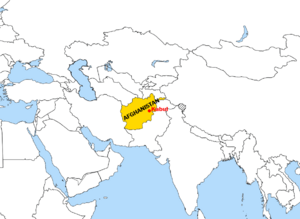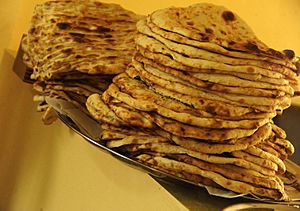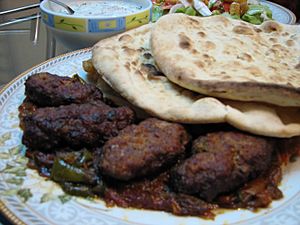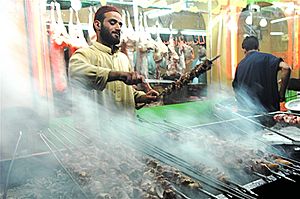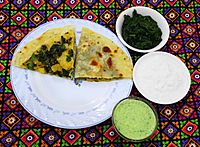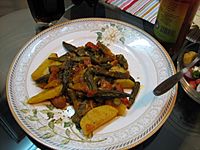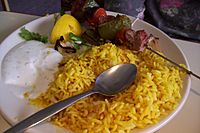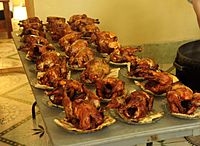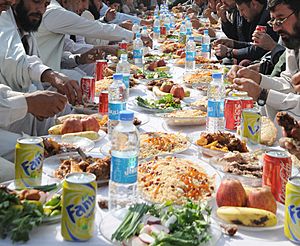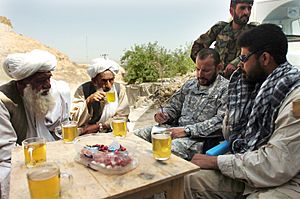Afghan cuisine facts for kids
Afghan cuisine is the delicious food from the country of Afghanistan. Its flavors are a special mix from nearby places like Persia (modern Iran), Central Asia, and South Asia. This is because Afghanistan has long been a center for travel and trade.
The food is mainly based on meats like mutton (sheep), beef, and chicken, served with lots of rice and special Afghan bread. Fresh vegetables, dairy products like yogurt, and many kinds of fresh and dried fruits are also very important. Most meals are halal, which means they are prepared following Islamic rules.
Rice dishes are a big part of the diet, and a warm piece of naan bread is almost always on the table. People also drink a lot of tea, especially when welcoming guests. The most famous meal, and the national dish of Afghanistan, is Kabuli palaw. It's a tasty rice dish made with raisins, carrots, nuts, and tender lamb or beef.
Contents
The Flavors of Afghan Cooking
Afghan food is known for being flavorful but not too spicy. Cooks use a variety of herbs and spices like coriander, mint, dill, and cumin to create wonderful tastes. A special spice called saffron, which grows in Afghanistan, is also used to add color and flavor.
Many dishes have a mix of sweet and sour flavors. This comes from using fruits, nuts, and legumes in savory rice dishes and stews. From warm dumplings to grilled kebabs, Afghan cuisine has a huge variety of meals to enjoy.
Staple Foods: The Heart of the Meal
Staple foods are the basic, important foods that people eat almost every day. In Afghanistan, the main staples are rice and bread.
Delicious Rice Dishes
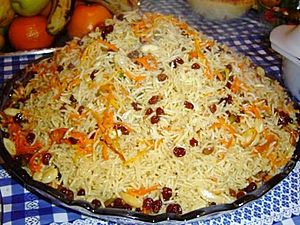
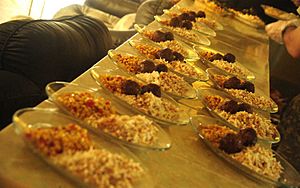
Rice is the star of Afghan cuisine. It's a very important part of almost every meal. There are two main ways to prepare it.
Challow is a simple white rice that is often served with stews, called qormas.
Palaw is a more complex rice dish. Meat, broth, and herbs are mixed in with the rice before it is baked. This gives the rice amazing colors, flavors, and smells. Some popular types of palaw are:
- Qabeli Palao: This is the national dish of Afghanistan. It's a rice dish cooked with meat and topped with fried raisins, carrots, and pistachios.
- Zamarod Palao: Spinach and other green herbs are mixed in, which turns the rice a beautiful green color. Zamarod means "emerald."
- Narenj Palao: A sweet and fancy rice dish made with saffron, orange peel, pistachios, almonds, and chicken.
Wonderful Afghan Bread
Afghan bread, called naan, is a type of flatbread. It is traditionally baked in a special clay oven called a tanoor or tandoor. The baker slaps the flat dough onto the hot inside wall of the oven, where it cooks quickly. This bread is eaten with almost every meal.
Famous Afghan Dishes
Afghanistan has many unique and tasty main dishes.
Steamed Dumplings: Mantu and Aushak

Dumplings are a favorite food for special occasions at home. They take a long time to make, so they are a sign of a special celebration.
- Aushak: These dumplings are filled with leeks and herbs. They are topped with a garlic-mint yogurt sauce and sometimes a seasoned meat sauce.
- Mantu: These are steamed dumplings filled with ground beef or lamb and onions. They are often served with a tomato sauce and a yogurt sauce, and sprinkled with dried mint.
Qormah: Hearty Stews
A qormah (also spelled korma) is a type of stew made with onions and tomatoes. It is usually served with white rice. There are many kinds of qormahs. Some are made with meat like lamb or chicken, while others are made with vegetables like spinach or turnips.
Kabob: Grilled to Perfection
Afghan kabob is meat grilled on skewers and is very popular. You can find it in restaurants and from street vendors. It is usually made with lamb and served with naan bread. Pieces of fat from the sheep's tail are sometimes added to the skewers to make the kabob extra juicy and flavorful.
Other popular kabobs are made with lamb chops, ribs, or chicken. A special type from eastern Afghanistan is the Chapli kebab. It is a flat, round patty made of minced beef, herbs, and spices.
Quroot: A Unique Dairy Food
Quroot (or qoroot) is a very interesting dairy product. It is made from the buttermilk left over after making butter from sheep's or goat's milk. The buttermilk is soured, salted, and boiled. The solid part is then pressed to remove the liquid and shaped into hard balls. The result is a very sour, hard cheese. Quroot is often grated over dishes like aushak and mantu to add a tangy flavor.
-
Bolani is a stuffed flatbread.
-
Cooked okra is often served as a side dish.
-
Afghan lamb kebab with yellow saffron rice.
Sweet Treats and Snacks
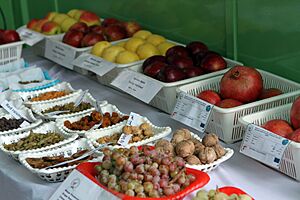
For dessert, Afghans usually eat fresh fruit. For snacks, they might have tea with cakes, cookies, or pastries. Some other popular desserts include:
- Baklava: A sweet pastry made of layers of filo dough, filled with chopped nuts and sweetened with syrup or honey.
- Firini: A sweet pudding made with milk and cornstarch, similar to rice pudding but without the rice.
- Shir Berenj: A sweet and creamy rice pudding.
- Gosh e Feel: Means "elephant's ear." It is a thin, fried pastry covered in powdered sugar and ground pistachios.
Soups and Drinks
- Shorwa is a simple and popular soup, often made with meat and vegetables.
- Aush is a hearty noodle soup made with herbs and beans.
The most popular drink in Afghanistan is chai, which means tea. It can be green or black tea. Most people drink green tea without sugar. Sometimes, cardamom or saffron is added for extra flavor.
Another popular drink is doogh. It is a cold and refreshing drink made by mixing yogurt and water, with a little bit of fresh or dried mint. It is especially popular in the summer.
Food from Different Regions
While many dishes are enjoyed all over Afghanistan, some ethnic groups have their own special foods.
Pashtun Cuisine
Pashtuns are the largest ethnic group in Afghanistan. Pashtun food often features a lot of meat. A famous dish is rosh, which is lamb cooked slowly with very few spices. Chapli kebab is also a well-known Pashtun dish.
Hazara Cuisine
The Hazara people live in the central part of Afghanistan. Their food is influenced by Central Asian, Persian, and South Asian cooking. They have their own unique ways of preparing dishes that are similar to those in neighboring regions.
Mealtime Traditions
Traditionally, meals are served on a special tablecloth called a dastarkhan that is spread on the floor. People sit around the dastarkhan to eat.
Food is almost always eaten with the right hand, not with forks or spoons. After the main meal is finished, tea and dessert are served.
Food for Special Occasions
During festivals and celebrations, it is a tradition to serve tea and nuql. Nuql are white sugared almonds. Welcoming guests with tea is a very important part of Afghan hospitality.
Images for kids
-
Cooked okra is also served for lunch or as a side dish
-
Afghan lamb kebab with yellow saffron rice
See also
 In Spanish: Gastronomía de Afganistán para niños
In Spanish: Gastronomía de Afganistán para niños


